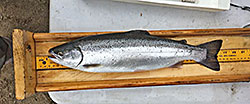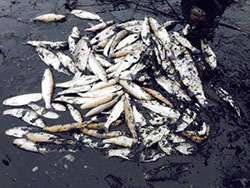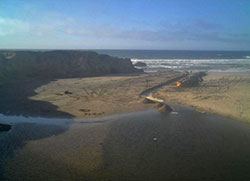
A healthy steelhead trout surveyed at Pescadero Creek Lagoon Complex in 2017

The aftermath of a winter sandbar breach 2014. These nearly annual breaches resulted in large die-offs for the lagoon’s steelhead.

A manual breach of Pescadero Creek Lagoon Complex. Managed breaches of the lagoon can prevent fish kills caused by turbulent natural breaches. Photo Courtesy of UC Davis School of Veterinary Medicine
There’s a dichotomy in the way Pescadero Creek Lagoon Complex in coastal San Mateo County has both supported—and been detrimental to—steelhead trout for much of the past 25 years.
On one hand, the lagoon complex—the largest tidal marsh between Elkhorn Slough and the San Francisco Bay estuary—boasts high growth rates for Central California Coast Steelhead. The lagoon system allows the species, which is federally listed as endangered, to reach a size that increases their likelihood of surviving at sea. Steelhead also use the system for juvenile rearing and resting during migration.
On the other hand, nearly every year since the mid-1990s, the lagoon faced harsh fall/winter sandbar breaches that filled the system with oxygen-depleted water and spread toxic sediment produced by the breakdown of organic matter like plant material in the absence of oxygen.
These breaches often resulted in large die-offs for the lagoon’s steelhead population. Historically, population estimates have reached as many as 17,000 steelhead rearing into the fall.
“It was a one-two punch where fish faced lack of oxygen and got hit with harsh toxic compounds. It was really unfortunate because the lagoon system works so well to grow steelhead, but we were losing the production every year,” said District Fisheries Biologist Jon Jankovitz.
Efforts to actively manage breaches began in 2012, but were stalled in 2014 and 2015 when the steelhead population was diminished due to drought conditions. In 2015, the California Department of Fish and Wildlife (CDFW) and the National Oceanic Atmospheric Administration (NOAA) partnered with the Department of Parks and Recreation (DPR), which owns much of the land associated with the complex, in adopting a monitoring and management plan.
In 2016, a significant fish kill caused by a turbulent sandbar breach prompted further action. CDFW, NOAA and DPR resumed active management to improve water conditions and prevent the deadly breaches.
The restoration team installed a sandbar dam at a major channel to slow the release of oxygen-depleted water and sediment into the system. Staff also preemptively manually breached the lagoon mouth on occasions when they anticipated a harmful natural breach.
Jankovitz conducts weekly water quality monitoring and twice-monthly dry-season fish sampling to inform management decisions. He produces an annual report on the health of the steelhead population and a summary of seasonal water quality transitions.
So how has active management faired? There hasn’t been a significant fish kill since 2016.
“We’ve saved the steelhead population for the last couple of years. We’re fortunate for the success we’ve had so far,” said Jankovitz.
Another mark of success has been the documented presence this year of sexually mature holdovers, meaning steelhead that were reared in the lagoon for two seasons even though they were large enough to smolt (i.e. migrate to sea).
“This obviously couldn’t happen if there was a fish kill the year prior. These holdovers represent a life history strategy that may fill in gaps during down reproductive years or periods of poor ocean conditions,” said Jankovitz.
There’s a long-term restoration plan in the works which would likely involve structural changes, such as relocating culverts and breaching levees, to alter the dynamics of how much tide flows in and out of the system. The plan includes a sediment removal project that was implemented in 2019 to increase fish passage.
Ultimately, CDFW and DPR would like to keep the system thriving without active management. “We don’t love breaching the lagoon manually because it can be stressful for fish and other aquatic species,” Jankovitz said.
Meanwhile, fostering an environment in Pescadero Creek Lagoon Complex that supports a large population of fast-growing steelhead continues to be top priority.
“Aside from being a native California species with a long history of recreational and angler use, steelhead are a great biological indicator of the health of streams and lagoon systems. The ecology of these systems would likely fall apart without them,” Jankovitz said.
Photos courtesy of CDFW District Fisheries Biologist Jon Jankovitz and the Bodega Marine Lab at University of California, Davis. Top Photo: District Fisheries Biologist Jon Jankovitz with a healthy Pescadero juvenile steelhead.
Media Contact:
Ken Paglia, CDFW Communications, (916) 322-8958